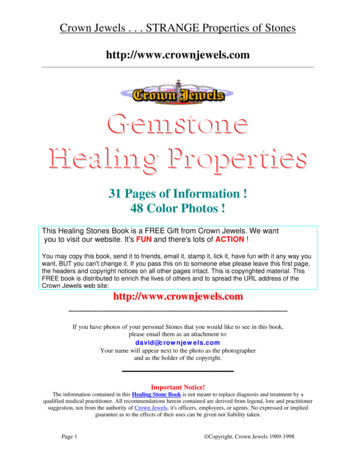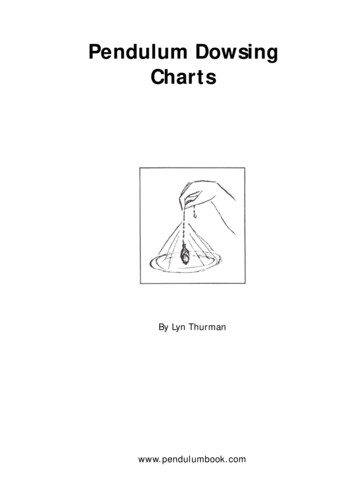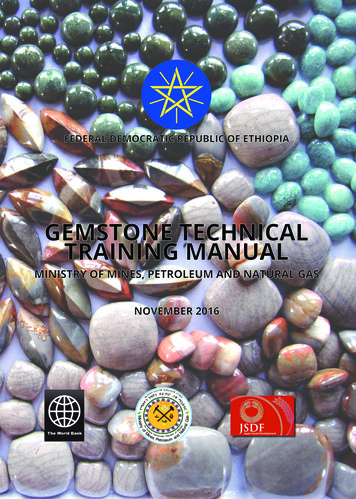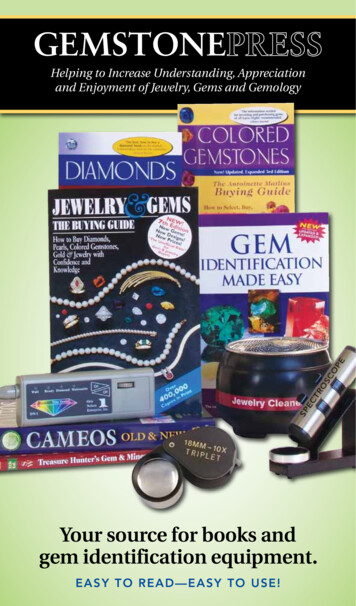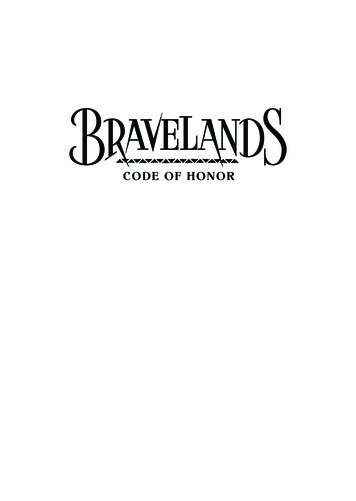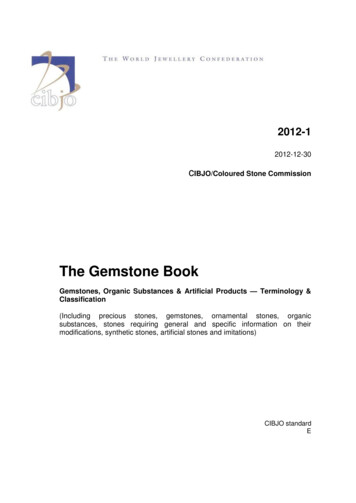
Transcription
2012-12012-12-30cIBJO/Coloured Stone CommissionThe Gemstone BookGemstones, Organic Substances & Artificial Products — Terminology &Classification(Including precious stones, gemstones, ornamental stones, organicsubstances, stones requiring general and specific information on theirmodifications, synthetic stones, artificial stones and imitations)CIBJO standardE
CIBJO 2012. All rights reserved.COLOURED STONE COMMISSION 2012-1Table of ContentsTable of Contents. 2Foreword. 3Introduction . 51Scope . 62Normative references . 63Classification of materials . 64Normative Clauses . 75Terms and Definitions . 18Annex A (normative) Commercial Names . 24Annex B . 58Bibliography . 60Index . 612
COLOURED STONE COMMISSION 2012-1 CIBJO 2012. All rights reserved.ForewordCIBJO is the French acronym for the Confédération Internationale de la Bijouterie,Joaillerie, Orfèvrerie, des Diamants, Perles et Pierres, which translates as theInternational Confederation of Jewellery, Silverware, Diamonds, Pearls and Stones(normally shortened to the International Jewellery Confederation). Founded in 1926as BIBOAH, a European organisation whose mission was to represent and advancethe interests of the jewellery trade in Europe, it was reorganised in 1961 and renamedCIBJO, in 2009 it was once again reorganized and officially named “CIBJO, The WorldJewellery Confederation”. Today CIBJO, which is domiciled in Switzerland, is a nonprofit confederation of national and international trade associations includingcommercial organisations involved in the jewellery supply chain. It now has membersfrom countries representing all five continents of the world. CIBJO printed its firstdeliberations on terminology and trade practices in 1968.It is the task of CIBJO to record the accepted trade practices and nomenclature for theindustry throughout the world. The records of the trade practices complement existingfair trade legislation of a nation or in the absence of relevant national laws they can beconsidered as trading standards. In countries where laws or norms exist, which conflictwith the laws, norms or trade practices in other countries, CIBJO will support thenational trade organizations to prevent trade barriers developing. The purpose ofCIBJO is to encourage harmonization, promote international co-operation within thejewellery industry, consider issues which are of concern to the trade worldwide and tocommunicate proactively with members. Foremost amongst these the aim is toprotect consumer confidence in the industry. CIBJO pursues all of these objectivesthrough informed deliberation and by reaching decisions in accordance with itsStatutes. CIBJO relies upon the initiative of its members to support and implement itsstandards, and to protect the trust of the public in the industry.The work of CIBJO is accomplished through Committees, Commissions and Sectors.Committees and Commissions consider standards for use in the jewellery supplychain. Sectors represent levels of trade in the jewellery industry. Sectors andcommissions advise the Executive Committee on current trade practices and issuesthat affect the jewellery industry.Three independent sectors exist within the confederation:Sector A - The Products SectorSector B - The Supply chain SectorSector C - The Service SectorThe Executive Committee may appoint Commissions that consider detailed issues. Atpresent these are:Coloured StoneDiamond EthicsGemmological3
COLOURED STONE COMMISSION 2012-1 CIBJO 2012. All rights reserved.PearlMarketing & EducationPrecious MetalsWorld Jewellers VigilanceThe Commissions for Diamonds, Gemstones, Pearls and Precious Metals havecollated the guidelines, which present the accepted trade practices for applyingdescriptions to these materials. It is in the best interest of all those concerned to beaware of them.The Sectors and Commissions will propose changes in the standards, also known asthe Blue Books, to the Executive Committee. After review the Executive Committeewill submit the accepted proposals for adoption to the Board of Directors and ifapproved they will notify the assembly of delegates of the changes at the annualcongress. Furthermore it is our mutual responsibility to support theserecommendations, which concern all professional people connected with diamonds,gemstones, pearls and precious metals. CIBJO Standards are subject to governmentregulations in the respective jurisdictions of CIBJO members.The national umbrella organization for each country represents, in principle, all thenational trade organizations involved in the sectors mentioned above. This democraticstructure, which has contributed to CIBJO‟s world-wide recognition also includesinternational trade and commercial organizations, it provides an international forum forthe trade to collectively draw attention to issues and implement resulting decisions.CIBJO Secretariat:CIBJO, The World Jewellery ConfederationPiazzale Carlo Magno, 120149 Milano, ItalyTel: 39-02-4997-7098 / 7097 / 6187 Fax: 39 02- 4997-7059E-mail: cibjo@cibjo.orgWeb site: www.cibjo.org4
COLOURED STONE COMMISSION 2012-1 CIBJO 2012. All rights reserved.Introduction5
COLOURED STONE COMMISSION 2012-1 CIBJO 2012. All rights reserved.GEMSTONES, ORGANIC SUBSTANCES ANDARTIFICIAL PRODUCTS — TERMINOLOGY ANDCLASSIFICATION1 ScopeThe terminology and classification of gemstones (5.25), organic substances (5.38) andartificial products (4.2) are established with reference to commercial usage, inconformity with the classifications and practices of the international gemstone, organicsubstance, artificial product and jewellery trades. The terminology and classificationsof gemstones, organic substances, and artificial products as set out herein shall beused by all traders participating as members of CIBJO member organizations within allmember nations.NOTE - CIBJO recognises that its standards are subject to government regulationsin the respective jurisdiction of CIBJOmembers.2 Normative referencesThe Diamond Book, CIBJO, International Confederation of Jewellery, Silverware,Diamonds, Pearls and Stones), the World Jewellery Confederation, Piazzale CarloMagno,1, 20149 Milano, Italy. cibjo@cibjo.orgThe Gemmological Laboratory Book, CIBJO, International Confederation ofJewellery, Silverware, Diamonds, Pearls and Stones), the World JewelleryConfederation, Piazzale Carlo Magno,1, 20149 Milano, Italy. cibjo@cibjo.orgThe Pearl Book, CIBJO (International Confederation of Jewellery, Silverware,Diamonds, Pearls and Stones), the World Jewellery Confederation, Piazzale CarloMagno,1, 20149 Milano, Italy. cibjo@cibjo.orgThe Precious Metal Book, CIBJO (International Confederation of Jewellery,Silverware, Diamonds, Pearls andStones), the World Jewellery Confederation, Piazzale Carlo Magno,1, 20149 Milano,Italy. cibjo@cibjo.org3 Classification of materialsThe jewellery industry and trade recognize two categories of material: naturalmaterials (5.34) and artificial products (4.2).6
COLOURED STONE COMMISSION 2012-1 CIBJO 2012. All rights reserved.4 Normative Clauses4.1 Natural materialsMaterials which have been formed completely by nature without human interferenceand subsequently modified only by means of cutting and polishing and thoseprocesses mentioned in clauses 4.1.3.1 and 4.1.3.2.4.1.1. Precious stones, Gemstones and Ornamental stonesNatural inorganic materials with the exceptions of metals used in jewellery orobjects d‟art (5.35). (See 5. 25 and 5.39)4.1.2. Organic substancesNatural materials (5.34) of organic origin used in jewellery or objets d’art (5.35).4.1.3. Modified gemstones and organic substancesPrecious stones (5.41), gemstones (5.25), ornamental stones (5.39) and organicsubstances (5.38) are often modified (5.33) by various processes, before and/or aftercutting, to improve their colour or clarity.There are two categories of modified gemstones and organic substances: Gemstonesand organic substances requiring general information of their modifications (4.1.3.1),and: gemstones and organic substances requiring specific information (4.1.3.2) of theirmodifications4.1.3.1 Gemstones and organic substances requiring general information ontheir modificationsGemstones and organic substances requiring general information on theirmodifications include those listed in clauses 4.1.3.1.1 to 4.1.3.1.4 only.4.1.3.1.1 . Substances present in fissures that do not add colourGemstones (5.25) and organic substances (5.38) modified by the presence withinfissures (5.20) of agents such as oil, wax, resin, polymer or any substances, otherthan glass that do not add colour to the gemstone or organic substance, when viewedat 10 power magnification by a trained observer.4.1.3.1.2 . Surface waxingGemstones (5.25) and organic substances (5.38) modified superficially with acolourless agent such as oil, wax, organic fluid or polymer.4.1.3.1.3 . Heating.Gemstones (5.25) and organic substances (5.38) permanently modified by heating7
COLOURED STONE COMMISSION 2012-1 CIBJO 2012. All rights reserved.(5.27).NOTE – A gemstone and organic substances may still be classified in this category whenresidues from the heating process are present within healed fissures. However, when healedfissures are polished flush with the surface of the stone, the residues should not be visibleby having a different polished surface lustre to the host material, when viewed at 10 powermagnification by a trained observer.4.1.3.1.4 . BleachingGemstones (5.25) and organic substances (5.38), other than pearls and culturedpearls, modified by bleaching (5.8).4.1.3.2 . Gemstones and organic substances requiring specific informationon their modificationGemstones and organic substances requiring specific information on theirmodifications are those not covered in clauses 4.1.3.1.1 to 4.1.3.1.4. Clauses4.1.3.2.1 to 4.1.3.2.6 list those modifications, presently known, that require specificinformation:4.1.3.2.1 . Artificial irradiationGemstones (5.25) and organic substances (5.38) with a colour altered by artificialirradiation (5.3).4.1.3.2.2 . Diffusion treatmentGemstones (5.25) and organic substances (5.38) with a colour altered by and/or anoptical phenomenon created by, diffusion treatment of chemical elements, with theexception of hydrogen and oxygen, from an external source (5.16).4.1.3.2.3 . Dyes or other colouring agentsGemstones (5.25) and organic substances (5.38) with a colour altered by dyes(5.18) or other colouring agents, or stones darkened by the “sugar/acid” process.4.1.3.2.4 . Filled fractures or cavitiesGemstones (5.25) and organic substances (5.38) modified by the filling (5.19) of openfractures (5.23) or cavities (5.10)NOTE – When filled fractures and cavities are polished flush with the surface of the stone, thefiller will be found to have a different polished surface lustre to the host material, when viewedat 10 power magnifications by a trained observer.4.1.3.2.5 . ImpregnationGemstones (5.25) and organic substances (5.38) modified by impregnation (5.29)with plastic or similar substances.8
COLOURED STONE COMMISSION 2012-1 CIBJO 2012. All rights reserved.NOTE – Clause 4.1.3.2.5 does not include the bonding of powdered materials. These areartificial products.4.1.3.2.6 . CoatingGemstones (5.25) and organic substances (5.385.12) modified by coating (5.12).4.1.4. Trade codesTrade codes (5.51) shall only be used within the industry; they are not to be used forthe consuming public. The codes are intended to facilitate the insertion of vitalinformation a) on tags attached to merchandise, b) on invoices, and or c) on othercommercial documents that are used within the trade.For definitions and instructions on how to use refer to annex A4.2 Artificial products4.2.1. Products that are partially or completely made by man.4.2.1.1 . Reconstructed stonesArtificial products (5.4) manufactured by melting (without subsequent crystallization),fusing natural materials to form a coherent whole.4.2.1.2 . Composite stonesArtificial products (5.4) composed of two or more, previously separate, parts or layersassembled by bonding or other artificial methods. Their components may be naturaland/or artificial.4.2.1.3 . Synthetic stonesArtificial products (5.4) having essentially the same chemical composition, physicalproperties and structure as that of their naturally occurring counterparts.4.2.2. Artificial stonesArtificial crystalline products with no known natural counterparts.4.2.2.1 . ImitationsArtificial products (5.4) that imitate the appearance of precious stones (5.41),gemstones (5.25), ornamental stones (5.39) or organic substances (5.38) withouthaving their chemical composition and/or their physical properties and/or theirstructure.9
COLOURED STONE COMMISSION 2012-1 CIBJO 2012. All rights reserved.4.3 General nomenclature – all materials4.3.1. DescriptionsPrecious stones (5.43), gemstones (5.25), ornamental stones (5.41), organicsubstances (5.40), reconstructed stones (5.45), composite stones (5.15), syntheticstones (4.11), artificial stones (5.5) and imitations (5.28) shall be named anddescribed in accordance with the terminology and classifications set out in all theclauses herein and Annexe A. This applies to the descriptions in all publications andcommunications addressed to the public as well as to all commercial documents (e.g.,advertisements, offers, labels, memos, delivery notes and invoices) and to appraisals,identification reports, certificates, etc.4.3.2. Names of cutsThe name of the cut shall only be used in conjunction with the correct name of thematerial from which it is fashionedExamples - « brilliant-cut sapphire », « rose-cut amber », « marquise-shape treatedtopaz », « baguette-shape YAG (artificial product) », « emerald-cut synthetic ruby »,« pear-shape garnet / glass doublet », « cabochon- cut reconstructed amber », «shell cameo »NOTE - A round brilliant-cut diamond may be described as a “brilliant” without any additionaldescription of the material. See diamond blue book.4.3.3. ChatoyancyStones displaying chatoyancy (5.11) shall be described by their correct name withthe prefix/suffix “cat‟s-eye” or the prefix “chatoyant”.Examples - « Cat‟s-eye tourmaline », « Tourmaline cat‟s-eye », « Chatoyanttourmaline »4.3.4. AsterismStones displaying asterism (5.7) shall be described by their correct name with theprefix “star” or “asteriated” or the suffix “asteria”.Examples - « Synthetic star ruby », « Asteriated quartz », « Quartz asteria »4.3.5. The term ―cultured‖The term “cultured” (5.15) or “cultivated” shall only be used for cultured pearls.10
COLOURED STONE COMMISSION 2012-1 CIBJO 2012. All rights reserved.4.3.6. The term ―semi-precious‖The term “semi-precious” (5.45) is misleading and shall not be used.4.3.7. Weight4.3.7.1 . Metric caratThe weight (5.56) of a stone shall be expressed in metric carats (ct); one carat isequivalent to 200 mg (1/5 g). The weight of a stone shall be stated in carats to twodecimal places.4.3.7.2 . RoundingWeight shall be rounded upwards if the third decimal is a 9, for example:0,996 0,99 ct0,998 0,99 ct0,999 1,00 ctNOTE - one-hundredth of a carat may be expressed as a “point”.NOTE - It is unfair trade practice to misrepresent the weight of any stone or to deceive as tothe weight of any stone. It is also an unfair trade practice to state or otherwise represent theweight of all stones contained in any article unless such weight figure is accompanied withequal emphasis and prominence by the words “total weight”, or words of similar meaning,so as to indicate clearly that the weight so stated or represented is that of all stones in thearticle and not that of the centre or largest one.4.3.8. MeasurementsThe measurements of a stone shall be expressed in millimetres to two decimal places.The following measurements shall apply; round shape: minimum diameter, maximum diameter and depth (total height); other shapes: length, width and depth (total height).4.4 Nomenclature - All natural materialsNOTE 1 - The adjectives “real” (5.42), “precious” (5.41), “genuine” (5.26) or “natural” (5.34)shall only be used to refer to or designate natural materialsNOTE 2 – It is unnecessary to note the genesis of a natural material, as the use of thecorrect name of the material alone and without qualification states that it is natural.11
COLOURED STONE COMMISSION 2012-1 CIBJO 2012. All rights reserved.4.4.1. Place of origin4.4.1.1 . Geographical areasNames of geographical areas shall only be used when they denote the areas wheregeographically mined or harvested (place of origin).4.4.1.2 . Origin opinionWhen places of origin for gemstones or organic substances are presented theyshall be considered as a matter of opinion.4.4.1.3 . Origin and qualityPlace of origin does not imply a level of quality.4.4.1.4 . Processing centres and places of originNames of cutting, processing or exporting centres shall not be used to implygeographical origin.4.5 Nomenclature – Gemstones and Organic Substances4.5.1. Description and commercial namesAnnex A lists the correct commercial names of the most common gemstones (5.25)and organic substances (5.38).NOTE 1 - the mineralogical name of a stone may be used in place of its commercialname(s) (e.g. olivine instead of peridot).NOTE 2 - the correct mineral name preceded or followed by a colour description maysubstitute for any variety or trade name.NOTE 3 – The biological or geological names of organic substances may be used instead ofthe commercial names.4.5.2. Mineralogical namesStones which are not listed in Annex A shall be described by their mineralogicalname (as recognized by the International Mineralogical Association) or geologicalname only.4.5.3. Biological namesOrganic substances (5.38) not specifically included within Annex A shall be describedby their biological names.12
COLOURED STONE COMMISSION 2012-1 CIBJO 2012. All rights reserved.4.5.4. Chatoyancy and asterismStones that display chatoyancy (5.11) or asterism (5.7) (whether listed in Annex A ornot) shall be described according to clauses 4.3.3 or 4.3.4.4.5.5. Approval of commercial namesAll commercial names not listed in Annex A, whether new or old, shall be submittedto CIBJO for approval and inclusion within this standard.4.5.6. Names of gemstones and organic substances used in directconjunction with each otherApart from the combinations given in Annex A, do not use the names of gemstones(5.25) and organic substances (5.38) in direct conjunction with each other (fordescription of colour or otherwise) in such a fashion, that the identity of the material isnot apparent.Examples of name combinations that shall not be used are: « alexandrite sapphire »,« topaz quartz », « citrine topaz », « topaz citrine ».4.6 Nomenclature - Gemstones and organic substances requiringgeneral information on their modifications4.6.1. DescriptionGemstones (5.25) and organic substances (5.38) requiring general information ontheir modifications (4.1.3.1.1 to 4.1.3.1.4) shall be named in the same way as theirunmodified counterparts (Annex A).Members of the trade shall have all information readily available on which modificationa given type of gemstone or organic substance has generally undergone and to submitsuch information to their customers. Commercial documents accompanying anddescribing a gemstone or organic substance requiring general information on itsmodification shall include a comment on this modification.4.7 Nomenclature – Gemstones and organic substances requiringspecific information of their modifications4.7.1. DescriptionA gemstone (5.25) or organic substance (5.38) requiring specific information of itsmodification (4.1.3.2.1 to 4.1.3.2.6) shall be described by the correct name of itsunmodified counterpart immediately preceded by the word “treated” (except as in thenote below) which shall appear, in the event of a written presentation, with equalemphasis and prominence, with characters of the same size and colour as those ofthe name itself. Do not abbreviate. Do not place an asterisk next to the name of a13
COLOURED STONE COMMISSION 2012-1 CIBJO 2012. All rights reserved.gemstone or an organic material, making reference to a footnote explanation of thefact that the stone is treated.NOTE - As an alternative to clause 4.7.1 the word “treated” may be replaced by the followingterms (where these terms apply is indicated by the relevant clause(s) in parenthesis andfollowing the term) providing that the application of these terms adhere to the requirementsregarding the term ”treated” in clause 4.7.1.“Irradiated” (5.31), “Artificially coloured” (4.1.3.2.1 to 4.1.3.2.3), ”Diffusion treated”(4.1.3.2.2), “Fracture filled” or “Glass filled” (4.1.3.2.4), ”Impregnated” (4.1.3.2.5),“Coated” (4.1.3.2.6).4.7.2. DisplayWhen materials described in clauses 4.1.3.2 and 4.7 or merchandise containing thesematerials are displayed (whether alone or mixed with other natural materials, in asingle piece of merchandise or otherwise), easily noticeable and legible labels,adjoining these loose stones or pieces of merchandise, shall clearly indicate theprecise nature of the objects being shown in accordance with the clauses herein.4.8 Nomenclature – All artificial products4.8.1. Artificial products used as imitationsAny artificial product may in certain situations comply with the classification anddefinition of an imitation (4.2 and 5.28). When this occurs the product may bedescribed in accordance with clause 4.13.4.8.2. DisplayWhen artificial products or merchandise containing artificial products are displayed(whether alone or mixed with natural materials, in a single piece of merchandise orotherwise), easily noticeable and legible labels, adjoining these loose stones orpieces of merchandise, shall clearly indicate the precise nature of the objects beingshown in accordance with the clauses herein.4.8.3. Names of geographic areaNames of geographical areas producing gemstones or organic substances and namesof cutting or exporting centres shall not be used when referring to artificial products.4.8.4. The adjectives―cultured‖ ural‖,Do not use the adjectives “real” (5.42), “precious” (5.41), “genuine” (5.26), “natural”(5.34), “cultured” (5.15) or any word or phrase of a similar meaning including“precious stone”, “gemstone” or “ornamental stone” in descriptions of artificialproducts.14
COLOURED STONE COMMISSION 2012-1 CIBJO 2012. All rights reserved.4.8.5. Names of natural materialsDo not use the name of any natural material in direct conjunction with the name of anartificial product (for description of colour or otherwise) in such a fashion, that theidentity of the stone is not apparent.Examples:(correct)- « emerald glass »- « aquamarine coloured synthetic spinel » (not correct)4.9 Nomenclature - Reconstructed stones4.9.1. DescriptionA reconstructed stone (5.43) shall be called by the correct name of itsnaturally occurring counterpart immediately preceded by the word “reconstructed”(except as in clause 4.8.1), which shall appear, in the event of a written presentation,with equal emphasis and prominence, with characters of the same size and colouras those of the name itself. Do not abbreviate. Do not place an asterisk next to thename of a gemstone or an organic material, making reference to a footnoteexplanation of the fact that the product is reconstructed.Example: «Reconstructed amber »4.9.2. Terms other than ―reconstructed‖Do not use a qualifying term other than “reconstructed” to describe anyreconstructed stone except as allowed for in clause 4.8.1.4.10 Nomenclature - Composite stones4.10.1 DescriptionComposite stones (5.14) shall (except as in clause 4.8.1) be described by the words“doublet” (two parts) or “triplet” (three parts) or “composite” (more than three parts see also clause 4.10.4 below), and these words shall be immediately preceded orfollowed by the correct names of the components of the assembled product (except asin clauses 4.10.2 and 4.10.3), the names of which shall be mentioned from the upperpart downwards and be separated by a slash (/). However, if all parts of a composite(excluding the bonding agent) are the same material, the name of this materialshall be stated only once. The words ”doublet” (5.17) or ”triplet” (5.53) or”composite” (5.14) shall appear, in the event of a written presentation, with equalemphasis and prominence, with characters of the same size and colour as those of thenames of the components. Do not abbreviate. Do not place an asterisk next to anyname or combination of names, making reference to a footnote explanation of thefact that the product is a composite stone.Examples: A doublet whose upper portion is a garnet and whose lower portion isglass shall be called a « garnet/glass doublet» or “doublet garnet/glass”.A composite stone composed of two parts of colourless synthetic spinel bondedtogether (by a coloured layer or otherwise) shall be called a “synthetic spinel15
COLOURED STONE COMMISSION 2012-1 CIBJO 2012. All rights reserved.doublet” or “doublet synthetic spinel”.4.10.2 Opal doubletA composition of two pieces where a slice of natural opal is bonded to a base materialshall be called an “opal doublet” or “doublet opal”.4.10.3 Opal tripletA composition of three pieces where a thin slice of natural opal is bonded to a darkbase and provided with a transparent top layer, usually domed and usually consistingof quartz or glass, shall be called an “opal triplet” or ”triplet opal”.4.10.4 Opal mosaicThe word “composite” shall be replaced by the word “mosaic”, when the variousparts of the composite are placed side by side (to create a picture or pattern orotherwise) providing that the application of this term adheres to the requirementsregarding the term ”composite” in clause 4.10.1.4.10.5 Terms other than those specified in clause 4.10Do not refer to any composite stone in any way other than that specified in clause4 . 1 0 (except as in clause 4.8.1).4.11 Nomenclature - Synthetic stones4.11.1 DescriptionA synthetic stone (5.50) shall be described (except as in clause 4.8.1) by the correctname of its naturally occurring counterpart immediately preceded by the word“synthetic” which shall appear, in the event of a written presentation, with equalemphasis and prominence, with characters of the same size and colour as those ofthe name itself. Do not abbreviate. Do not place an asterisk next to the name of agemstone, making reference to a footnote explanation of the fact that the product issynthetic.Example: « synthetic emerald »4.11.2 . Terms other than ―synthetic‖Do not use a qualifying term other than “synthetic” to describe any synthetic stoneexcept as allowed for in clause 4.8.1.4.11.2.1 . The term “synthetic” may be replaced by the terms “laboratory-grown” or“laboratory created”NOTE - In the event that the national jewellery association, which is a member of CIBJO,deems that there is no acceptable local direct translation of the English terms „laboratory-16
COLOURED STONE COMMISSION 2012-1 CIBJO 2012. All rights reserved.grown‟ or „laboratory-created,‟ then only the translation of the term „synthetic‟ should beused.4.11.3 . Brand or manufacturers namesWhen using a brand name or the manufacturer‟s name these shall be added to thename of the stone (5.50) in one of the following manners:Examples: « synthetic emerald by (name) », « (name) synthetic emerald »4.12 . Nomenclature - Artificial stones4.12.1 DescriptionThe name of an artificial stone shall be used in conjunction with the term “artificialproduct” (5.4) or “artificial stone” (5.5) (except as in clause 4.8.1) which must appear,in the event of a written presentation, with equal emphasis and prominence, withcharacters of the same size and colour as those of the name itself. Do not abbreviate.Do not place an asterisk next to the name of an artificial stone, making reference to afootnote explanation of the fact that the product is artificial.4.12.2 Name similaritiesThe name of an artificial stone shall not show a similarity to the name, or sound of thename (neither entirely, nor abbreviated, nor by way of an allusion), of any naturalmaterial nor be an established name for another artificial stone.Correct examples:for artificial yttrium aluminate, « YAG - artificial product », or « - YAG - artificial stone »for artificial lithium niobate, « Linobate - artificial product » or « Linobate - artificialstone ». Incorrect examples:do not use « Diamantine », « Diamlite », « Diamonair », « Smaryll », « Emeraldolite »etc.4.12.3 Terms other than ―artificial product‖ or ―artificial stone‖Do not use a qualifying term other than “artificial product” (5.4) or “artificial stone”
4.1.3. Modified gemstones and organic substances Precious stones (5.41), gemstones (5.25), ornamental stones (5.39) and organic substances (5.38) are often modified (5.33) by various processes, before and/or after cutting, to improve their colour or clarity. There are two categories of modified gemstones and organic substances: GemstonesFile Size: 1MBPage Count: 64Explore furtherGemstone Identification Chart - Best Chart in The Web .gemfame.comGIA Gem Encyclopedia Complete List Of Gemstoneswww.gia.eduPicture Identification Guide for Polished Stones and .storage.cloversites.comHow to Identify Gemstones (with Pictures) - wikiHowwww.wikihow.comTumbled Gemstone Identification Chart Provided by RockTumblerrocktumbler.comRecommended to you b
